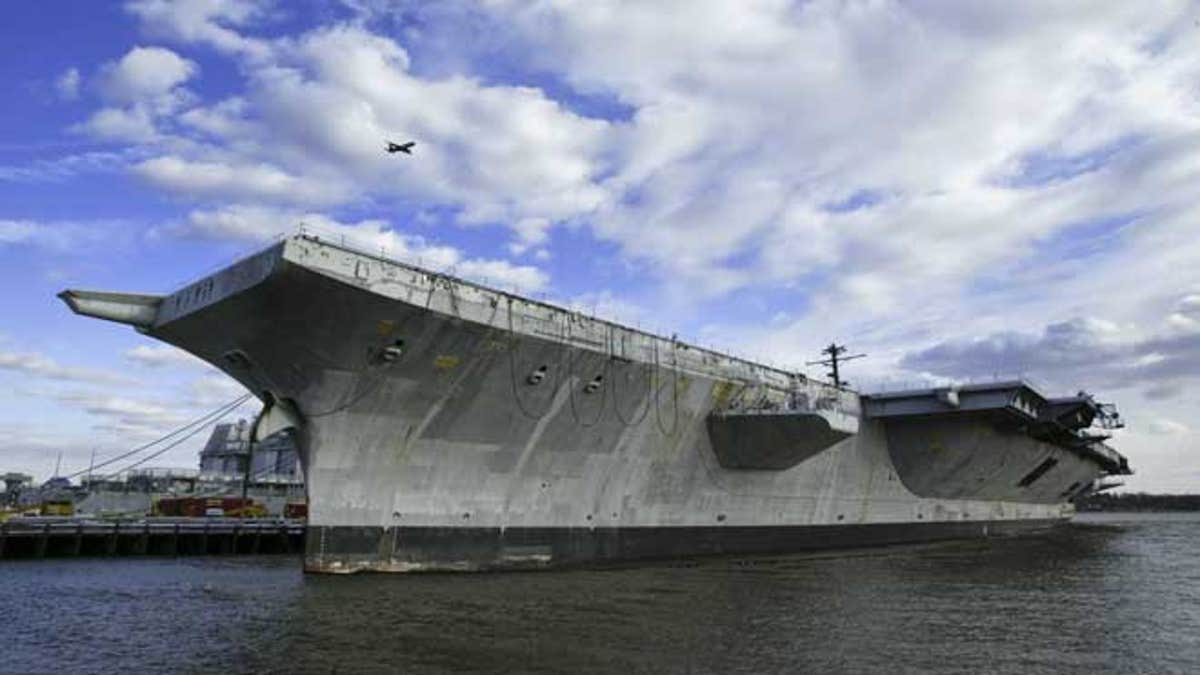Navy to resume sinking old ships in US waters
{{#rendered}} {{/rendered}}
In this March 2, 2005 file photo, the aircraft carrier USS America is shown in Philadelphia. (AP)
The U.S. Navy is resuming its practice of using old warships for target practice and sinking them in U.S. coastal waters after a nearly two-year moratorium spurred by environmental and cost concerns.
Later this month, three inactive vessels -- Kilauea, Niagara Falls and Concord -- will be sent to a watery grave off Hawaii by torpedoes, bombs and other ordnance during the Rim of the Pacific naval exercises, or RIMPAC.
The military quietly lifted the moratorium on Sinkex, short for sinking exercise, last year after a review of the requirements, costs, benefits and environmental impacts of the program, the Navy said in a statement to The Associated Press.
{{#rendered}} {{/rendered}}It will be the first time since 2010 the Navy has used target practice to dispose of an old ship. Previous targets have ranged from small vessels to aircraft carriers such as the USS America, which was more than three football fields long.
Conservation groups argue that the ghost ships should instead be recycled at a ship-breaking facility. Concerns about the long-lasting effects of toxic pollutants onboard the ships spurred a lawsuit by those groups to force the Environmental Protection Agency to better catalog and regulate Sinkex. The case, filed in U.S. District Court in San Francisco, is ongoing.
The groups said they did not plan to seek an injunction to stop the Navy from restarting the exercises.
{{#rendered}} {{/rendered}}"We are appealing to the Navy to continue their moratorium at least until our case is heard," said Colby Self of the environmental group Basel Action Network, which joined the Sierra Club in suing the EPA. "After the vessels hit the sea-bottom, it will be a little too late to redress damages to our precious marine resources."
The Navy says Sinkex offers valuable live-fire training for times of war and provides clean vessels for at-sea, live-fire exercises. The ships can be targeted from the air, ocean's surface or underwater, with the results aiding the acquisition, planning and design of future vessel classes and systems, the Navy said.
For decades, the Navy destroyed the vessels with little or no oversight. Then in 1999, the EPA ordered the Navy to better document toxic waste left on the doomed ships while removing as much of the material as possible. In return, the EPA exempted the military from federal pollution laws that prohibit any such dumping in the ocean.
{{#rendered}} {{/rendered}}The Navy is still in charge of estimating the amount of pollutants onboard after the ships are prepared for sinking. In addition, the Navy must file an annual report with EPA estimating the amount of PCBs, or polychlorinated biphenyls, carried by the vessels.
High levels of the chemical are believed to increase the risk of certain cancers in humans. It was banned by the U.S. in 1979 in part because it is long-lasting and accumulates throughout the food chain.
Vice Admiral Gerald Beaman, commander of the combined task force running the exercises, said Monday that each ship will be stripped of PCBs and other contaminants such as asbestos, as required by the Navy's agreement with EPA.
{{#rendered}} {{/rendered}}"There are severe restrictions that are placed on any hulk of that nature," Beaman said during a news conference at Pearl Harbor, flanked by commanders from participating countries.
The Navy must also conduct the exercises at least 50 nautical miles from shore and in water at least 6,000 feet deep.
Beaman said decisions about sinking the ships versus recycling them are made outside the scope of the exercises.
{{#rendered}} {{/rendered}}A previous AP review of records from the past 12 years found the Navy got rid of most of its old ships over that time through target practice. Records show the Navy sunk 109 peeling, rusty U.S. warships off the coasts of California, Hawaii, Florida and other states during that period.
Navy documents show some of the ships it sunk contained an estimated 500 pounds of PCBs.
During the same time, 64 ships were recycled at one of six approved domestic ship-breaking facilities.
{{#rendered}} {{/rendered}}RIMPAC, which lasts for five weeks, features training exercises for thousands of military personnel from 22 nations.
